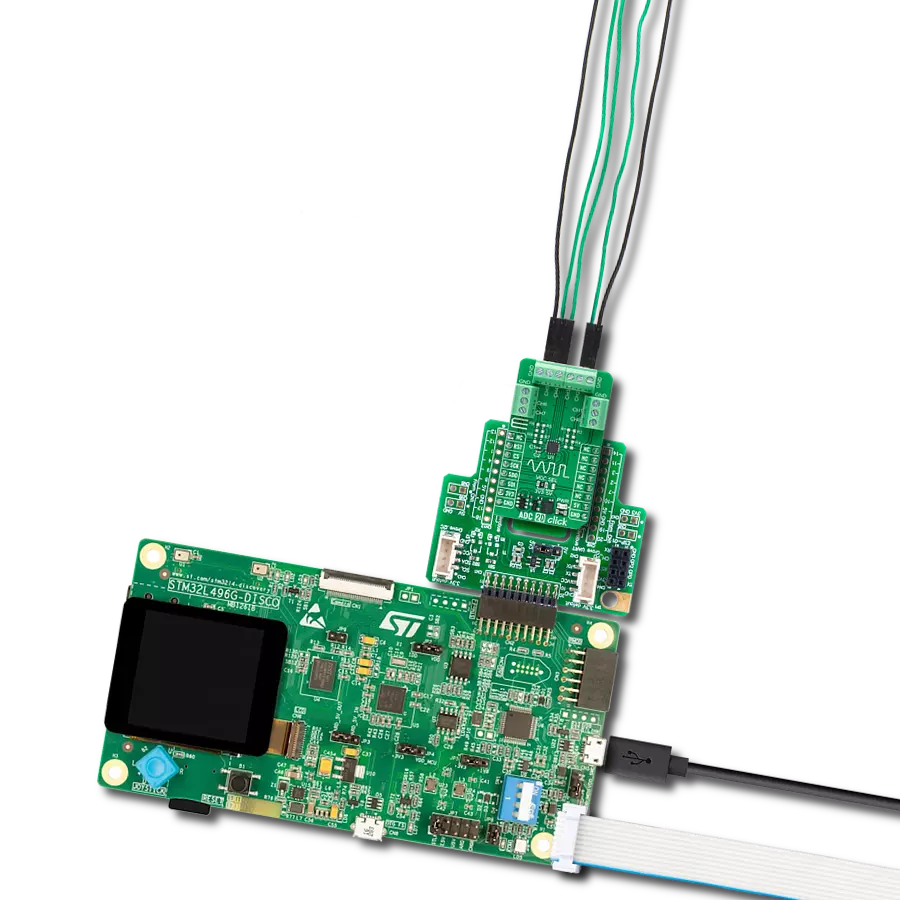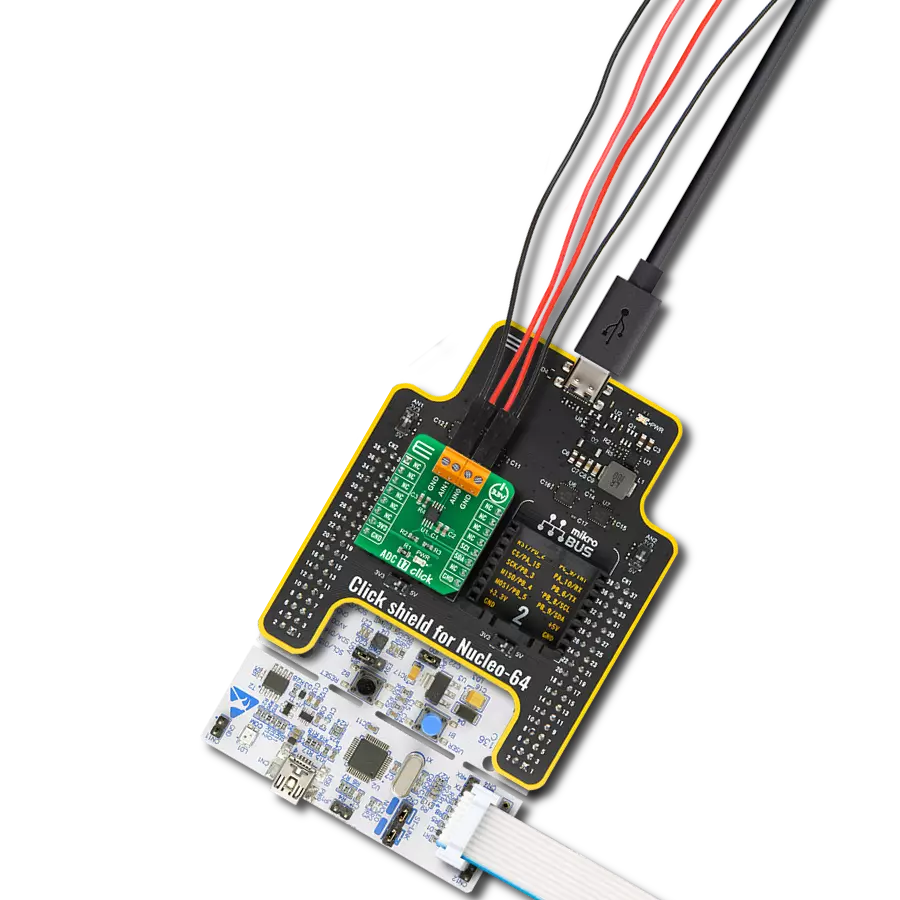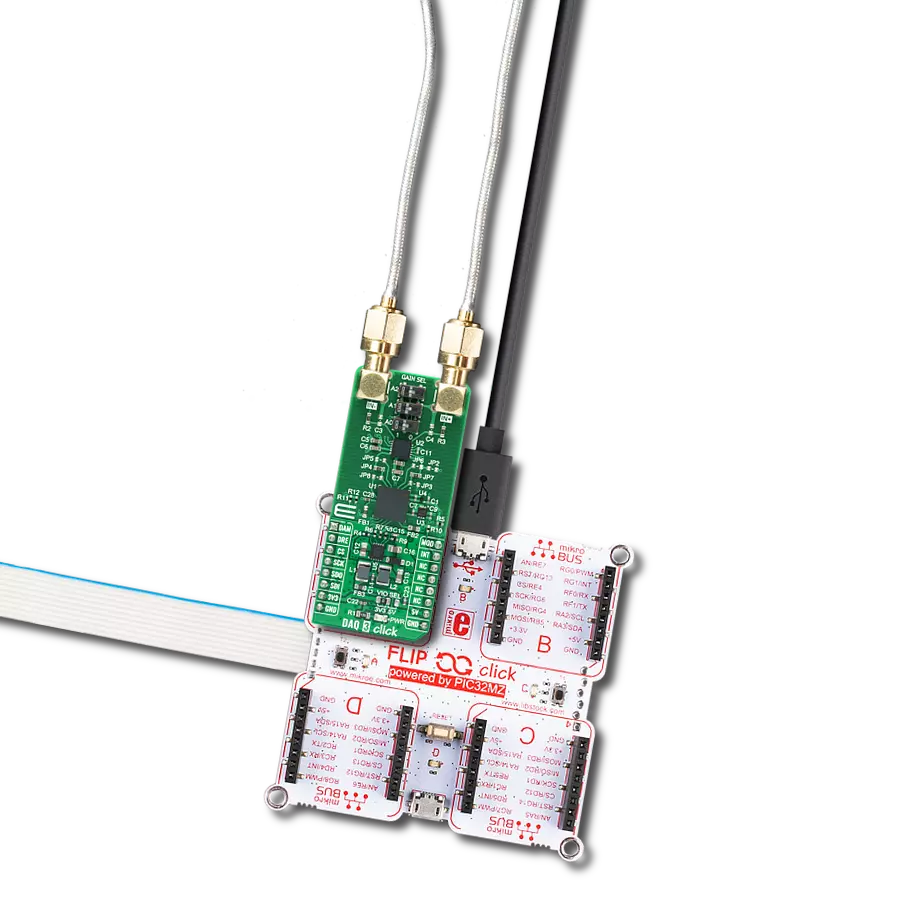Our analog-to-digital converter seamlessly transforms complex analog signals into precise digital data, ensuring unparalleled accuracy in every conversion.
A
A
Hardware Overview
How does it work?
ADC 22 Click is based on the ADS8665, a 12-bit high-speed single-supply SAR ADC data acquisition system with programmable bipolar input ranges from Texas Instruments. This ADC operates on a single 5V supply used from the mikroBUS™ power rail and supports true bipolar input ranges of ±12.288V, ±6.144V, ±10.24V, ±5.12V, and ±2.56V, as well as unipolar input ranges of 0 to 12.288V, or 10.24V, 6.144V, and 5.12V. The gain and offset errors are accurately trimmed within specified values to ensure a high DC precision for each input range. The input range selection is made by software. The ADC features an overvoltage protection circuit of up to ±20V and an on-chip 4.096V reference with extremely low-temperature drift. In addition, ADC 22 Click is equipped with an external voltage reference REF header, which allows you to apply voltages to
ADS8665 ADC from 4.046 up to 4.146V. You can separate the grounds for external voltage reference usage by desoldering the NET TIE R2 resistor. The ADC 22 Click features alarm functions that consist of an input alarm and an AVDD supply alarm. The alarm function should be enabled over the software, thus enabling both alarm functions by default. You can later separately disable one of them. Another neat feature of this Click board™ is the RVS multi-function output pin, which, regarding the CS pin status, can reflect the status of the internal ADCST signal or the status of the RVS depending on the output protocol selection. The device allows the output clock on the RVS pin to be synchronous to either the external clock provided on the SCLK pin or to the device's internal clock. In all SRC modes of operation, the RVS pin provides the output clock, synchronous to
the device data output. The RVS pin can be monitored for timing benefits. ADC 22 Click uses a standard 4-Wire SPI serial interface to communicate with the host MCU supporting high serial clock frequency. It also supports an enhanced SPI interface (multiSPI) that maximizes the sampling rate even with lower-speed host controllers. The alarm interrupt is available on the INT pin, and you can reset the device over the RST pin. The RVS pin is a multi-function pin for the serial interface. This Click board™ can operate with either 3.3V or 5V logic voltage levels selected via the VCC SEL jumper. This way, both 3.3V and 5V capable MCUs can use the communication lines properly. Also, this Click board™ comes equipped with a library containing easy-to-use functions and an example code that can be used as a reference for further development.
Features overview
Development board
PIC18F57Q43 Curiosity Nano evaluation kit is a cutting-edge hardware platform designed to evaluate microcontrollers within the PIC18-Q43 family. Central to its design is the inclusion of the powerful PIC18F57Q43 microcontroller (MCU), offering advanced functionalities and robust performance. Key features of this evaluation kit include a yellow user LED and a responsive
mechanical user switch, providing seamless interaction and testing. The provision for a 32.768kHz crystal footprint ensures precision timing capabilities. With an onboard debugger boasting a green power and status LED, programming and debugging become intuitive and efficient. Further enhancing its utility is the Virtual serial port (CDC) and a debug GPIO channel (DGI
GPIO), offering extensive connectivity options. Powered via USB, this kit boasts an adjustable target voltage feature facilitated by the MIC5353 LDO regulator, ensuring stable operation with an output voltage ranging from 1.8V to 5.1V, with a maximum output current of 500mA, subject to ambient temperature and voltage constraints.
Microcontroller Overview
MCU Card / MCU

Architecture
PIC
MCU Memory (KB)
128
Silicon Vendor
Microchip
Pin count
48
RAM (Bytes)
8196
You complete me!
Accessories
Curiosity Nano Base for Click boards is a versatile hardware extension platform created to streamline the integration between Curiosity Nano kits and extension boards, tailored explicitly for the mikroBUS™-standardized Click boards and Xplained Pro extension boards. This innovative base board (shield) offers seamless connectivity and expansion possibilities, simplifying experimentation and development. Key features include USB power compatibility from the Curiosity Nano kit, alongside an alternative external power input option for enhanced flexibility. The onboard Li-Ion/LiPo charger and management circuit ensure smooth operation for battery-powered applications, simplifying usage and management. Moreover, the base incorporates a fixed 3.3V PSU dedicated to target and mikroBUS™ power rails, alongside a fixed 5.0V boost converter catering to 5V power rails of mikroBUS™ sockets, providing stable power delivery for various connected devices.
Used MCU Pins
mikroBUS™ mapper
Take a closer look
Click board™ Schematic

Step by step
Project assembly
Software Support
Library Description
This library contains API for ADC 22 Click driver.
Key functions:
adc22_get_voltage- ADC 22 get voltage level function.adc22_get_adc_raw_data- ADC 22 get ADC raw data function.adc22_set_range- ADC 22 set range function.
Open Source
Code example
The complete application code and a ready-to-use project are available through the NECTO Studio Package Manager for direct installation in the NECTO Studio. The application code can also be found on the MIKROE GitHub account.
/*!
* @file main.c
* @brief ADC 22 Click example
*
* # Description
* This example demonstrates the use of the ADC 22 Click board™
* by reading and writing data by using SPI serial interface and reading results of AD conversion.
*
* The demo application is composed of two sections :
*
* ## Application Init
* Initialization of SPI module and log UART.
* After driver initialization, the app executes a default configuration.
*
* ## Application Task
* The demo application reads the voltage levels from analog input and displays the results.
* By default, the operating input range sets from 0V to 12.288V [3×Vref;Vref=4.096V].
* Results are being sent to the UART Terminal, where you can track their changes.
*
* @author Nenad Filipovic
*
*/
#include "board.h"
#include "log.h"
#include "adc22.h"
static adc22_t adc22;
static log_t logger;
void application_init ( void )
{
log_cfg_t log_cfg; /**< Logger config object. */
adc22_cfg_t adc22_cfg; /**< Click config object. */
/**
* Logger initialization.
* Default baud rate: 115200
* Default log level: LOG_LEVEL_DEBUG
* @note If USB_UART_RX and USB_UART_TX
* are defined as HAL_PIN_NC, you will
* need to define them manually for log to work.
* See @b LOG_MAP_USB_UART macro definition for detailed explanation.
*/
LOG_MAP_USB_UART( log_cfg );
log_init( &logger, &log_cfg );
log_info( &logger, " Application Init " );
// Click initialization.
adc22_cfg_setup( &adc22_cfg );
ADC22_MAP_MIKROBUS( adc22_cfg, MIKROBUS_1 );
if ( SPI_MASTER_ERROR == adc22_init( &adc22, &adc22_cfg ) )
{
log_error( &logger, " Communication init." );
for ( ; ; );
}
Delay_ms ( 100 );
if ( ADC22_ERROR == adc22_default_cfg ( &adc22 ) )
{
log_error( &logger, " Default configuration." );
for ( ; ; );
}
Delay_ms ( 100 );
log_info( &logger, " Application Task " );
log_printf( &logger, " ----------------\r\n" );
Delay_ms ( 100 );
}
void application_task ( void )
{
static float voltage = 0.0;
if ( ADC22_OK == adc22_get_voltage ( &adc22, &voltage ) )
{
log_printf( &logger, " Voltage : %.2f V\r\n", voltage );
log_printf( &logger, " ----------------\r\n" );
Delay_ms ( 1000 );
}
}
int main ( void )
{
/* Do not remove this line or clock might not be set correctly. */
#ifdef PREINIT_SUPPORTED
preinit();
#endif
application_init( );
for ( ; ; )
{
application_task( );
}
return 0;
}
// ------------------------------------------------------------------------ END
Additional Support
Resources
Category:ADC



































